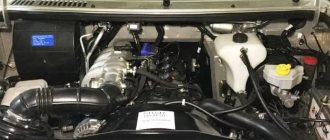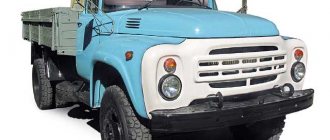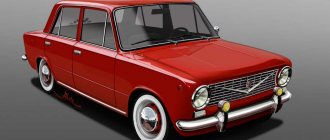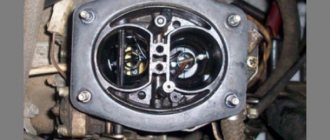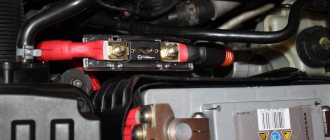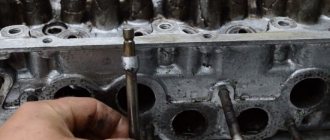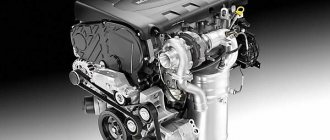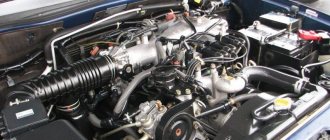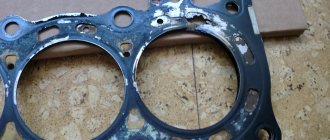Description
The F3R engine is a 2.0-liter four-cylinder in-line naturally aspirated gasoline engine with a power of 114 hp. s and a torque of 171 Nm. In 1992, under the designation B20F, it was supplied to the Volvo concern, and since 1997 - to our AZLK.
The engine was installed on Renault cars:
- Laguna I (1993-2001);
- Megane I (1995-2000);
- Espace III (1996-2000);
- Scenic I (1996-1999).
For Volvo cars (under the symbol B20F):
- V 440 (1993-1996);
- V 460 (1993-1996);
- V 480 (1992-1995).
Additionally, from 1997 to 2001, it was under the hood of the Russian Moskvich (AZLK) “Svyatogor”.
The cylinder block is cast iron, the cylinders are machined in the body of the block.
The cylinder head is made of aluminum alloy. The camshaft is fixed in the upper part in five supports.
The pistons are standard, with three rings, two of which are compression and one is oil control.
Drives: timing belt – toothed belt, oil pump – chain.
There are no hydraulic compensators; the thermal clearance of the valves is adjusted by selecting washers.
Adjusting the thermal gap
Repair of Moskvich-2141 engines
UZAM engines are highly maintainable, and as parts wear out, the engines can be repaired without any problems. ICE crankshafts 331/3317/3318 have four repairs; there are connecting rod and main bearings with a repair increase of 0.25/0.5/0.75/1.00 mm. If the shaft cannot be ground (does not fit all existing sizes), it must be replaced.
The cylinder liners of Ufa engines are easily removable and are installed in the block with copper seals. The liners can also be bored; on UMZ engines there are two repair sizes, respectively, there are pistons;
- first repair +0.5 mm;
- second repair +1.00 mm.
For the VAZ-2106 engine, the crankshaft also has 4 types of repair liners, two types of repair pistons (piston rings). But the cylinders are bored not every 0.5 mm, but every 0.4 mm, that is, on the 2106 engine model there are repair pistons:
- first repair +0.4 mm;
- second repair +0.8 mm.
There is another important difference between VAZ and UZAM engines:
- cylinder liners on Ufa engines are rarely bored - they are easier and more convenient to replace as part of the piston group;
- on VAZ engines, the liners are pressed, and therefore the cylinder block always has to be bored, and when the last repair size is reached, the BC must be relined on a special machine.
"Moskvich-214145-Svyatogor" is a 5-door passenger car that has been produced at the Moscow AZLK plant since 1997. Compared to previous 2140 models, this new product received a completely different line of engines, and also significantly changed its appearance. “Svyatogor-Moskvich” is very similar in appearance to popular foreign cars of the 1990s. However, is he like that on the inside? Find answers to these and many other questions in our auto review.
Specifications
| Manufacturer | Cleon Plant |
| Engine volume, cm³ | 1998 |
| Power, l. With | 114 |
| Torque, Nm | 171 |
| Compression ratio | 9.8 |
| Cylinder block | cast iron |
| cylinder head | aluminum |
| Cylinder diameter, mm | 83 (82,7)* |
| Piston stroke, mm | 93 |
| Cylinder operating order | 1-3-4-2 |
| Number of valves per cylinder | 2 |
| Timing drive | belt |
| Hydraulic compensators | No |
| Fuel supply system | injector |
| Fuel | gasoline AI-95 |
| Lubrication system, l. | 5,5 (5,1)* |
| Environmental standards | Euro 2-3 |
| Declared/real resource, thousand km | 150+/500+ |
| Location | transverse/longitudinal* |
*values in brackets for the engine installed on the Moskvich “Svyatogor”
Heart defect: why AZLK-2141 never had its own engine
Alas, AZLK’s long-time partner, the Ufa plant, took this idea with hostility, abandoning work on modernizing the “four hundred and twelve engine” and increasing the working volume. The official reason is “due to the limited capabilities of the equipment for processing crankshafts.” It became clear to the factory workers that the “new heart” for the future Moskvich would have to be developed on their own.
Unfortunately, a significant layer of the developments of AZLK designers was “buried” due to personnel vicissitudes: after former ZIL employees began managing the plant in 1976, they began to consider the option of purchasing a license to produce a finished car - just as it was done at VAZ.
By that time, the USSR Ministry of Automotive Industry had also decided that the new AZLK model should have front-wheel drive. The “front-wheel drive” theme was fashionable around the world – and it was gaining momentum even in the Soviet Union. By that time, the Togliatti plant had already been developing the future G8 for several years, and in Moscow they were working on promising models of the classic layout, reasonably reasoning that many world manufacturers (Mercedes, BMW) remained faithful to the rear-wheel drive layout. The decision issued from above threw AZLK back almost a decade - after all, in fact, the work had to be done from scratch.
From someone else's shoulder
Since no one was going to allocate money to purchase a license for the production of some front-wheel drive car like the Renault 16, the factory workers had to develop a new Moskvich based on the French car Simca 1307. The car was not bad and even became the Car of the Year 1976, but... Redraw body shapes are one thing, but developing a power unit for an unfamiliar layout is another. Moreover, the original “Simka” had a motor located transversely and not longitudinally.
1 / 3
2 / 3
3 / 3
Thus, the future “forty-one” turned out to be deprived of its own “heart”: in a hurry, the designers had to adapt the “four hundred and twelve engine” at their disposal directly on a real French hatchback.
The factory workers aptly named the early prototype Maksimka
But it immediately became obvious that for a powerful and expensive car of a higher class than previous Muscovites, this engine is weak both in terms of developed power and maximum torque. In order to still put the model on the assembly line in the mid-eighties, as an alternative it was decided to use the engine of the main competitor of AZLK - from a VAZ car. The most powerful engine at that time was the “six” engine - as you know, a rear-wheel drive car. That’s right - front-wheel drive Sputniks were simply not produced yet during the work on the “forty-first”, and the factory workers had to adapt engines from the “classics” - their own model 2140 and the “luxury” Zhiguli 2106 - to the front-wheel drive Moskvich.
This circumstance forced the designers to “peep” the layout of VAG cars - in particular, the Audi 100 model.
1 / 2
2 / 2
After all, classic engines had to be positioned longitudinally, since due to the center-to-center distance of the cylinders, installing them transversely along with the transmission would be very problematic. On the one hand, this required increasing the front overhang and moving the radiator of the cooling system to the left side, and on the other hand, it provided the car with a fairly spacious interior, taking into account the external dimensions. True, the engines themselves had to be somewhat modernized, changing the intake parts and lubrication systems according to the layout requirements.
1 / 2
2 / 2
1 / 4
2 / 4
3 / 4
4 / 4
Heart disease
Even the “six” engine in the locally modified version 2106-70 with its eighty horsepower turned out to be clearly too weak for the new Moskvich, and there is nothing to say about the Ufa engine, which was outdated by that time - especially since due to layout inconsistencies the designers had to “ “strangle” it with the suboptimal height of the intake manifold, which ultimately reduced the engine output to 72 hp. With.
1 / 3
2 / 3
3 / 3
And Soviet motorists have already managed to try out the new Togliatti car of the eighth model, which even in the basic 1.3-liter version turned out to be very dynamic. In addition, the five-door “nine” had an “eighty-third” 1.5-liter engine, 70 “horses” of which provided the new VAZ with a confident advantage over its competitors. This was how the first nail was hammered into the coffin of the “forty-one” - the car was expensive (over nine thousand rubles!), but at the same time it had rather mediocre dynamics. Of course, many Soviet pensioners were quite satisfied with the dynamics of the AZLK-2141 and -21412, but... the car was predicted to have a great future, which it clearly did not justify with such “physical training”. Many preferred to buy either a classic Zhiguli or a more frisky and “youthful” Samara - especially since the Moskvich was more expensive than the “nine”!
The UZAM-331.10 (b) engine was not very different from the source for the M-412. And that’s not for the better.
Already when the first Muscovites found their happy (not always) owners, the plant began to actively engage in the “motor theme”. After all, it was obvious that the modernized Moskvich engine with the UZAM-331.10 index would not go far, and VAZ supplied the “six” engine in limited quantities (and then only at the beginning of production).
Articles / History Wheels of the Land of Soviets: what Muscovites “shoeed” in. Cars of the Moscow Automobile Plant are as much a part of the history of the Soviet automobile industry as the production association itself. Nevertheless, many of the Muscovites are still in service and reeling in... 57405 2 8 10/17/2015
The motor that never existed
It became clear to the management of the Moscow Automobile Plant that they would have to build their own engine-building enterprise and develop the engine for the “forty-one” and subsequent models independently.
As we have already told you, not only AZLK specialists got down to business, but also VAZ workers. For this purpose, the Ministry of Automotive Industry even organized a special competition for the design of the motor, the results of which were reviewed by the technical council of the ministry in March 1987. According to the council’s conclusions, the Togliatti version had “deeper technological development,” but the design from AZLK was potentially more economical and simpler.
An interesting detail: the engine was originally conceived as a family of different units, not only running on gasoline, but also diesel! But at that time, passenger diesel simply did not exist in the USSR!
At the VDNKh exhibition in Moscow, two engines were presented - gasoline with the index 21414 and diesel 21423. A cast-iron four-cylinder block with a rigid casting, an aluminum cylinder head with an overhead eight-valve timing belt with a belt drive - the design of both options turned out to be quite traditional. At the same time, diesel and gasoline were pretty much unified, which promised to reduce the cost of production preparation and simplify the provision of spare parts in the future.
1 / 4
2 / 4
3 / 4
4 / 4
Both specialists and ordinary consumers were pleased that the 1,800 cc units turned out to be powerful - 95 hp. With. for gasoline and 65 liters. With. – for the diesel version, which was quite normal given its atmosphere.
In comparison with the Zhiguli engine available on the 41st, the new engines were noticeably lighter, more compact and more economical.
1 / 2
2 / 2
At the time the engines were presented to the general public, piles had already been driven into the AZLK territory and the columns of the engine housing had begun to be installed, where the designed units were to be produced. Subsequently, the engine line was supplemented with a sixteen-valve version of the 21416 gasoline engine and a 21413 turbodiesel. Thus, in the future, the “forty-one” would finally get rid of “heart failure” by receiving its own engines of sufficient power.
1 / 3
2 / 3
3 / 3
On the experimental sports Aleko-141KR, the engine “moved” to the rear of the body
Alas, the plans were not destined to become a reality: in 1991, the USSR collapsed, and funding for the project was suspended. The plant itself had no time for motor production, because in the late eighties, VTB Bank took out a loan of $800 million for the purchase of imported equipment, which was hanging on the enterprise. As a result, the engine-building "foreigners" - in the early nineties, the 1.8-liter "all-Ford" FORD RTF (XLD418) engine was installed on export modifications, and in the mid-nineties, the "forty-one" finally found a decent engine - a two-liter Renault F3R272 gasoline engine from Mexico production, providing the Moscow car with accelerating dynamics comparable to sixteen-valve VAZs. Since 1994, the volume of Ufa engines nevertheless increased to 1.7-1.8 liters planned back in the seventies, but... by the end of the twentieth century, the most powerful Soviet automobile plant was on the verge of bankruptcy. That is why the fate of the AZLK-2141 was predetermined regardless of which of the foreign engines was under its long hood.
MIRACLE-ELKO
In 1988, in Germany, they tried to use the ELKO diesel engine of the German company Elsbett at AZLK-2141. Thanks to original design solutions, the three-cylinder supercharged diesel engine running on biofuel (!) turned out to be very economical and environmentally friendly, while its power-to-weight ratio surprised even experts. However, the motor turned out to be too vibration-loaded.
“Forty-one” with an ELKO diesel engine demonstrated unique efficiency: fuel consumption averaged about four and a half liters per hundred, and during the “out of the competition” performance at the Soviet eco-rally, the crew managed to show a fantastic result - 2.69 l/100 km ! The factory workers immediately put the miracle engine into circulation, planning to produce 120,000 cars each with such a power unit, but technological and, most importantly, financial limitations put an end to the practical implementation of the ELKO project. No miracle happened.
What do modifications mean?
The improvement of the engine gave rise to many modifications. They didn’t have any big differences from each other, especially in the mechanical part. Performance characteristics were also identical. All the differences were in the attachments in relation to the car models on which they were installed.
For example, the F3R 611 modification had an aluminum pan, an injector and two ignition coils. Intended to equip automatic transmission.
The F3R 722 modification was connected to a manual transmission, the pan was steel, the injector remained the same, and there was one high-voltage coil for four spark plugs.
The F3R 272 version used in Russia (on the Moskvich Svyatogor) had a cast aluminum crankcase and a chain-driven oil pump. The location in the car is longitudinal.
On versions of the engine with index 768 and higher, the technology for adjusting the thermal clearances of the valves has been changed (to replace the pushers you have to raise the camshaft).
| Engine code | Power | Torque | Compression ratio | Years of manufacture | Installed |
| F3R 611 | 114 l. s at 5400 rpm | 168 Nm | 9.8 | 1995-2001 | Laguna I |
| F3R 722 | 115 l. s at 5250 rpm | 162 Nm | 9.5 | 1994-1999 | Laguna (B/K56) |
| F3R 723 | 115 l. s at 5250 rpm | 162 Nm | 9.5 | 1994-1999 | Laguna (B/K56) |
| F3R 728 | 115 l. s at 5250 rpm | 168 Nm | 9.8 | 1996-1999 | Laguna (K56L) |
| F3R 729 | 115 l. s at 5250 rpm | 168 Nm | 9.8 | 1996-1999 | Laguna (K56L) |
| F3R 742 | 114 l. s at 5250 rpm | 168 Nm | 9.8 | 1996-2000 | Espace III |
| F3R 750 | 115 l. s at 5400 rpm | 168 Nm | 9.8 | 1995-1999 | Megane (B/DA0G) |
| F3R 751 | 115 l. s at 5400 rpm | 168 Nm | 9.8 | 1995-1999 | Laguna (B/DA0G) |
| F3R 752 | 114 l. s at 5400 rpm | 168 Nm | 9.7 | 1999-2002 | Megane I |
| F3R 768 | 114 l. s at 5400 rpm | 162 Nm | 9.8 | 1995-2001 | Laguna I, Espace III |
| F3R 769 | 114 l. s at 5400 rpm | 168 Nm | 9.8 | 1995-2001 | Laguna I |
| F3R 791 | 109-114 l. s at 5400 rpm | 168 Nm | 9.7 | 1998-2001 | Megane I |
| F3R 796 | 109 l. s at 5400 rpm | 168 Nm | 9.7 | 1996-1999 | Scenic I |
| F3R 797 | 114 hp at 5400 rpm | 168 Nm | 9.7 | 1997-1999 | Megane I |
| F3R 798 | 109-114 l. s at 5400 rpm | 168 Nm | 9.7 | 1998-2003 | Megane I |
| F3R 272 | 113 l. s at 5250 rpm | 168 Nm | 9.8 | 1997-2002 | AZLK 214145 "Svyatogor" |
Reliability, weaknesses, maintainability
The characteristics of the engine are significantly supplemented by three important factors with which it becomes more complete.
Reliability
Car owners and service station workers call the F3R the most reliable and successful of all engines. This is largely due to the fact that the engine was developed on the basis of a diesel internal combustion engine. Hence the durability and significant resource.
With proper operation, careful treatment and timely maintenance, the engine can easily maintain more than 500 thousand km without major repairs.
The unit successfully combines the strength and simplicity of all mechanisms. The owner of Renault Laguna I from Belarus, LaguhaVod, writes: “... personal experience of owning an F3R 768 for 7 years and about 600,000 km. The motor is simple and reliable.”
Traction and power indicators satisfy the needs of any driving style. The most acceptable option is a non-aggressive, calm and measured ride. In this case, peak loads do not occur, causing breakdowns of engine components and parts.
To increase the reliability of the internal combustion engine, it is necessary to use high-quality filling fluids, especially fuel and oil.
Indirect confirmation of the high reliability of the F3R is its use in cars produced by other automakers.
Weak spots
The disease of the “French” is electrical. The sensors, dual-coil ignition system, and high-voltage wires are not particularly reliable. Electrical problems can be easily resolved at any car service center.
The engine practically cannot tolerate overheating. In most cases, this ends in a not entirely cheap repair of the cylinder head (a slightly misaligned head can sometimes be polished, but its gasket and valve stem seals will have to be replaced). Significant overheating causes the piston rings to stick and causes increased oil consumption. The solution to the problem lies on the surface - monitor the coolant temperature, do not overheat the engine.
A major danger is a broken timing belt. In such a situation, bending of the valves is inevitable. The manufacturer recommends changing the belt every 60 thousand km. If this operation is performed earlier, the number of weak points on the engine will be reduced.
And, perhaps, the last trouble is the need to adjust the thermal clearance of the valves. But this is already a problem for car service workers.
When analyzing the weak points of the unit, it turns out that in most cases they appear due to the fault of the car owner (violation of maintenance regulations, refueling with low-quality fuel, etc.).

